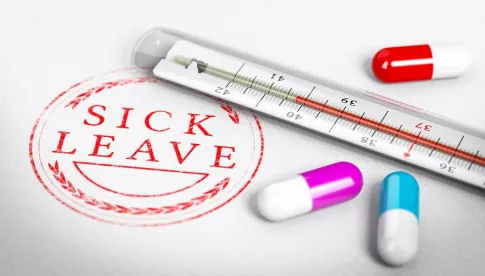New York State has released an informal guidance page, including frequently asked questions, regarding the newly enacted statewide paid sick leave law, which took effect on September 30, 2020.
As we have previously reported, the law requires employers with New York employees to provide a certain amount of paid or unpaid sick leave to be used for certain medical and employee safety-related reasons. Specifically, under the new law:
-
employers with 4 or fewer employees and a net income of less than $1 million in the prior tax year must provide employees with up to 40 hours of unpaid sick leave.
-
employers with between 5 and 99 employees and employers with 4 or fewer employees and a net income of greater than $1 million in the prior tax year must provide each employee with up to 40 hours of paid sick leave per year.
-
employers with 100 or more employees must provide up to 56 hours of paid sick leave per year.
Employees must accrue sick leave at a rate of at least 1 hour for every 30 hours worked. Alternatively, employers may fulfill their obligation under the law by providing the full amount of sick leave in a lump sum at the beginning of each year.
The newly released guidance provides additional color on a number of the requirements under the new law. Among the key highlights:
Employee Coverage and Amount of Leave to Be Provided
-
The law applies to all private sector employees – including full-time, part-time, and seasonal employees, as well as both exempt and non-exempt employees – and includes employees of charter schools, private schools, and not-for-profit corporations. However, federal, state, and local government employees are not covered.
-
Employees who telecommute for New York employers outside of New York State are covered by the law only for any hours when they are physically working in New York State. This is also true where the employer is also physically located outside of New York State.
-
For purposes of determining an employer’s total number of employees in a calendar year (and therefore the amount of sick leave the employer is obligated to provide), employers must use the 12-month period from January 1 to December 31. The guidance does not, however, clarify whether employers should count employees working outside of New York State as part of their total employee count.
Providing, Paying, and Use of Sick Leave
-
For purposes of determining when employee accrual begins anew or when new time is to be frontloaded each year, an employer may utilize any 12-month period as the “calendar year” (such as the employer’s fiscal year or an employee’s anniversary date).
-
Employers utilizing a frontloading system may not later revoke or reduce the amount of sick leave provided if the employee works fewer hours than anticipated in the year.
-
Employers may utilize a frontloading system for part-time employees that provides a bank of sick leave time equivalent to what they would otherwise accrue (under the 1 hour of sick leave for every 30 hours worked calculation) based on the hours they are anticipated to work in that year. However, if an employer frontloads fewer than the maximum required hours under the law, the employer must still track the employee’s hours worked and accrual of sick leave in the event the employee ends up working more hours than previously anticipated. In such case, the employer must allow the employee to accrue additional leave (at the 1 hour for every 30 hours worked rate) until the total amount of frontloaded plus accrued time reaches the maximum required hours under the law, and the employee must be allowed to use all such frontloaded and accrued time in that calendar year. Further, the employee must be allowed to carry over any unused sick leave for immediate use in the following year, in addition to being frontloaded the amount of time the employee is expected to earn in the new calendar year, though the employer may still set a usage cap of 40 or 56 hours based on size.
-
Paid sick leave must paid at the employee’s regular rate of pay. While a non-exempt employee may use available sick time for scheduled hours that would otherwise qualify as overtime hours if worked, an employer is not required to pay the employee at their overtime rate for such hours. For employees with multiple pay rates, sick leave must be paid at a weighted average of those rates. Employer who utilize a tip allowance against minimum wage requirements are not permitted to do so for such employee’s sick leave – rather, such employees would be entitled to the statutory minimum wage applicable to the employee.
-
An employee is entitled to use sick leave upon oral or written request, and there is no specified minimum notice period requirement under the law.
-
Unused sick leave need not be paid out by the employer at the end of the employment relationship. For seasonal employees who “maintain an ongoing employment relationship with their employer,” they must be permitted to maintain their sick leave accruals across any breaks in employment.
Collectively Bargained Employees
-
Collective bargaining agreements entered into on or after September 30, 2020 may provide for different leave benefits as those set forth under the law, so long as: (i) such benefits are “comparable benefits” to those required by law; and (ii) the agreement specifically acknowledges and references the provisions of the Section 196-b of the New York Labor Law (which is the provision incorporating the paid sick leave law).
-
The guidance further recommends that “the ‘comparable benefits for the employees’ be explicitly identified and labeled as such in the agreement to avoid confusion and misunderstanding.”
Interplay With Other Leave Laws
-
Both the New York City Earned Safe and Sick Time Act (“ESSTA”) and the Westchester County Paid Sick Leave Law remain enforceable as to covered employees to the extent the requirements under those laws meet or exceed those of the statewide paid sick leave law.
-
The New York State sick leave law “operates independently from other State and Federal leave requirements” and “must therefore be paid in addition to any other State or Federal leave entitlements.” This includes the New York State COVID-19 leave law, as well as leave under the federal Families First Coronavirus Response Act.
* * *
Employers are encouraged to review the new guidance and ensure that their sick leave policies are up to date with the latest requirements. Further, employers with employees in New York City are reminded that ESSTA has also been recently amended, largely to bring the law in line with the state law.




 />i
/>i
